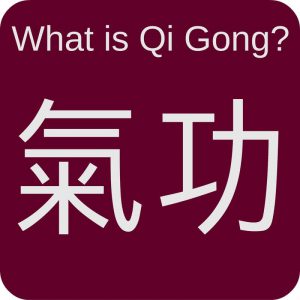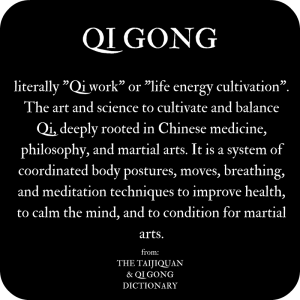What is Qi Gong? Answered with quotes
I have to admit that when I started Taijqiuan (Tai Chi Chuan) in 2004, I had no idea about Qi Gong (氣功). I went to class and was quite (happily) surprised when we did many wonderful exercises at the beginning and the end of class. My teacher said those are Qi Gong exercises. And I wondered “what is Qi Gong”?
Before I explain what is Qi Gong, let’s talk Chinese first! Or at least listen to it. If you wonder how to pronounce Qi Gong properly, play this and repeat – or have a look at my blogpost about how to pronounce Qi Gong!
Qi Gong can be quite confusing, becauses there are actually quite a lot of Qi Gong exercises, systems and sets. One of the reasons for that is: Qi Gong is sooooo old. The documented history goes back app. 2500 years. And Qi Gong-like techniques might be even more than 5000 years old!
As you can imagine, over thousands of years, gazillions of Qi Gong exercises where created. Exercises can be done singularly. Or you can practice complete sets consisting of different successive moves, postures, Qi Gong meditations etc. Well known Qi Gong sets are e.g. 8 brocades Qi Gong, 5 animals Qi Gong, Yi Jin Jing Qi Gong etc.
But now you really want to know what is Qi Gong, so let’s have a look at some definitions:
What is Qi Gong?
“Qi Gong: A type of Gongfu training which specializes in building up the Qi circulation in the body for health and/or martial purposes.”
from: Tai Chi Tai Chi Theory & Martial Power*, p. 261
“Qigong is an ancient Chinese health care system that integrates physical postures, breathing techniques and focused intention. The word Qigong (Chi Kung) is made up of two Chinese words. Qi is pronounced chee and is usually translated to mean the life force or vital-energy that flows through all things in the universe. The second word, Gong, pronounced gung, means accomplishment, or skill that is cultivated through steady practice. Together, Qigong (Chi Kung) means cultivating energy, it is a system practiced for health maintenance, healing and increasing vitality.
Qigong practices can be classified as martial, medical, or spiritual. All styles have three things in common: they all involve a posture, (whether moving or stationary), breathing techniques, and mental focus. Some practices increase the Qi; others circulate it, use it to cleanse and heal the body, store it, or emit Qi to help heal others. Practices vary from the soft internal styles such as Tai Chi; to the external, vigorous styles such as Kung Fu. However, the slow gentle movements of most Qigong forms can be easily adapted, even for the physically challenged and can be practiced by all age groups.”
Source: National Qigong Association
“Qigong is a form of gentle exercise composed of movements that are repeated a number of times, often stretching the body, increasing fluid movement (blood, synovial and lymph) and building awareness of how the body moves through space.
When you practice and learn a qigong exercise movement, there are both external movements and internal movements. These internal movements or flows in China are called neigong or “internal power”. These internal neigong movements make qigong a superior health and wellness practice.
The internal movements also differentiate qigong from almost every other form of exercise in the West that often emphasizes prolonged cardiovascular movements (such as in running and biking) or that focus on muscular strength training (weight lifting).”
Source: Bruce Frantzis
“Qigong, (simplified 气功; traditional: 氣功; Pinyin: qìgōng; Wade–Giles: chi gong; literally: “Life Energy Cultivation”) is a holistic system of coordinated body posture and movement, breathing, and meditation used for health, spirituality, and martial arts training. With roots in Chinese medicine, philosophy, and martial arts, qigong is traditionally viewed as a practice to cultivate and balance qi (chi), translated as “life energy”. (…) Over the centuries, a diverse spectrum of qigong forms developed in different segments of Chinese society. Traditionally, qigong training has been esoteric and secretive, with knowledge passed from adept master to student in lineages that maintain their own unique interpretations and methods. Qigong practices were brought to the public beginning in the 1950s, when the Communist Party institutionalized and began research into traditional Chinese medicine. Although the practice of qigong was prohibited during the Cultural Revolution of the 1960s; it was once again allowed after 1976. On account of the political climate at the time, the emphasis of qigong practices shifted away from traditional philosophy and cultivation, and increasingly focused health benefits, medicine and martial arts applications, and a scientific perspective.”
Source: Wikipedia
“Qigong is a powerful system of healing and energy medicine from China. It is the art and science of using breathing techniques, gentle movement, and meditation to cleanse, strengthen, and circulate the life energy (qi). Qigong practice leads to better health and vitality and a tranquil state of mind.
In the past qigong was called nei gong (inner work) or dao yin (guiding energy). Today, the original ancient word for qigong is being revived: yang sheng. Yang sheng means “nurturing” (yang) “life” (sheng). This beautiful term includes not only healing exercises and meditations but also any practices that contribute to physical, mental, emotional, and spiritual balance. Nor is yang sheng restricted to personal well-being. To nurture life is to live in a way that cares for the life around us, all of nature.”
Source: Ken Cohen (author of The Way of Qigong*)
“Qigong, which literally means “practice of vital energy”, is an ancient Chinese art of meditation and physical exercise. When it is practiced correctly, it promotes health, mental well-being, martial arts skills, and spiritual development. There are many types of qigong systems. Most qigong systems incorporate breathing techniques, moving exercises, massage techniques, still postures, and mental training. Qigong is well-known in China and is now popular in the United States for its development of internal energy, promotion of healing, reduction of stress, and extension of life.”
Source: Taijiquan Chen Family
“Qigong is the path—the energy exercise that allows you to become part of the Universe.”
Source: Nan Lu from TCM World
“Qi Gong is not really just an exercise; it can become a powerful way of being. For people with health challenged as well as those who simply wish to increase their personal energy and inner calm, ancient Chinese Qi Gong could be a gift of a lifetime”
from The Healing Promise of Qi* (pages vii & 5)
Last but not least I would like to add my own defition of Qi Gong from my book The Taijiquan & Qi Gong Dictionary*:
Now I hope you have a better picture of what is Qi Gong. And after reading a lot about it you might want to do some little exercises right now! Have a look at my collection of easy 5 minutes Qi Gong exercises and start right away!
Happy Qi!
Angelika


